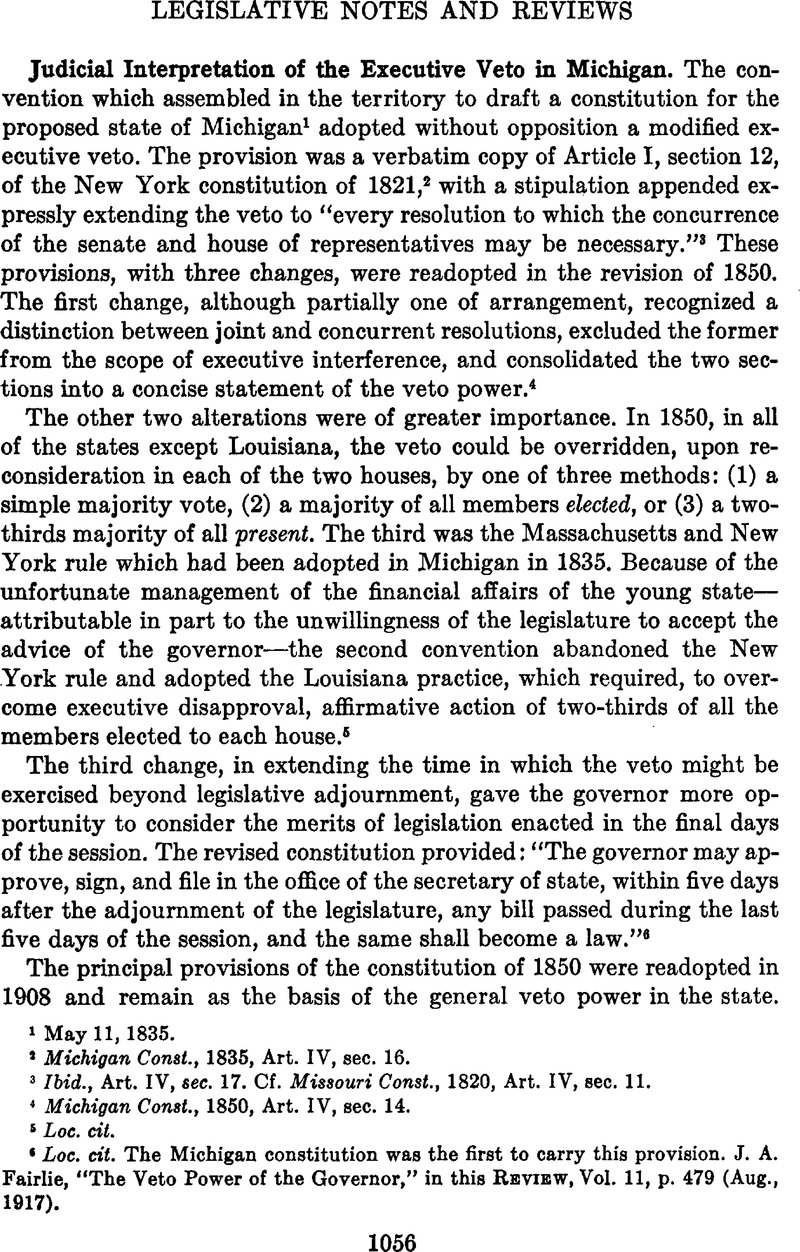No CrossRef data available.
Article contents
Judicial Interpretation of the Executive Veto in Michigan
Published online by Cambridge University Press: 02 September 2013
Abstract

- Type
- Legislative Notes and Reviews
- Information
- Copyright
- Copyright © American Political Science Association 1934
References
1 May 11, 1835.
2 Michigan Const., 1835, Art. IV, sec. 16.
3 Ibid., Art. IV, sec. 17. Cf. Missouri Const., 1820, Art. IV, sec. 11.
4 Michigan Const., 1850, Art. IV, sec. 14.
5 Loc. cit.
6 Loc. cit. The Michigan constitution was the first to carry this provision. Fairlie, J. A., “The Veto Power of the Governor”, in this Review, Vol. 11, p. 479 (Aug., 1917)Google Scholar.
7 Michigan Const., 1908, Art. V, sec. 37.
8 Less than three per cent of all bills vetoed since 1909 have become law contrary to executive disapproval and less then ten per cent have been proposed for reconsideration.
9 “The powers of government are divided into three departments: the legislative, executive, and judicial. No person belonging to one department shall exercise the powers properly belonging to another, except in the cases expressly provided in this constitution.” Michigan Const., 1909, Art. IV.
10 Wood v. State Administrative Board, 255 Mich. 224 (1931).
11 See Opinions of the Attorney-General, Michigan, 1895, pp. 275–276Google Scholar. This report is based upon a California court opinion. “In approving a law, he [the governor] is not supposed to act in the capacity of the executive magistrate of the state, whose duty it is to see that the laws are properly executed, but as a part of the legislative branch of the government. This power is a unit, though distributed; and the parts can only act in unison. Whenever a part ceases to act, the whole becomes imperative.” Fowler v. Pierce, 2 Cal. 165. However, the Michigan court intimated that it would not have followed the California opinion had it been presented with a similar question. “If we were construing the provisions of the earlier constitution, we should therefore feel justified in concluding that the governor might sign a bill within ten days after its passage, though the legislature should have meantime adjourned.” City of Detroit v. Chapin, 108 Mich. 138 (1895).
12 Michigan Const., 1850, Art. IV, sec. 14.
13 City of Detroit v. Chapin, 108 Mich. 136 (1895).
14 Ibid., pp. 141–142.
15 Michigan Const., 1908, Art. V, sec. 36.
16 Three measures have become law without executive approval: Governor Ferris refused to take definite action on two occasions, and another bill was declared to have become law when Governor Sleeper's intended veto came one day late. Since 1909, only two governors have “pocketed” measures.
17 Only ten per cent of bills disapproved between 1909 and 1934 were vetoed during the working days of the legislative sessions. All others came on the final day or in the interim between temporary and final adjournments.
18 Opinions of the Attorney-General, Michigan, 1911, pp. 283–284Google Scholar. “An essential element of a veto is that the governor ‘shall return it with his objections to the house in which it originated.‘” Wood v. Administrative Board, 255 Mich. 230.
19 “Neither house shall, without the consent of the other, adjourn for more than three days, nor to any other place than where the legislature may then be in session.” Michigan Const., Art. V, sec. 18.
20 Wood v. State Administrative Board, 255 Mich. 231.
21 Loc. cit.
22 Okanogan Indians v. United States, 279 U.S. 655. The gist of the opinion is: “It follows, in our opinion, that under the constitutional mandate it [the vetoed measure] is to be returned to the ‘house’ when sitting in an organized capacity for the transaction of business, and having authority to receive the return, enter the President's objections on its journal, and proceed to reconsider the bill; and that no return can be made to the house when it is not in session as a collective body and its members are dispersed” (p. 683).
23 Wood v. Administrative Board, 255 Mich. 229–232.
24 Opinions of the Attorney-General, Michigan, 1909, pp. 123–125Google Scholar.
25 So generally accepted was this practice that the governors did not even go to the trouble of returning partially vetoed bills to the houses for reconsideration. Such bills were filed, along with approved measures, in the office of the secretary of state and appropriations made accordingly.
26 Wood v. State Administrative Board, 255 Mich. 225–226.
27 Ibid., p. 225. The court accepted as ruling authority: Strong v. People, ex rel. Curran, 74 Cal. 283; Fairfield v. Foster, 25 Ariz. 146; Fergus v. Russel, 270 I11. 304; Peebly v. Childers, 95 Okla. 40; Mills v. Porter, 69 Mont. 325; Fulmore v. Lane, 104 Tex. 499; and dismissed Commonwealth v. Barnett, 199 Pa. 161, with the statement that the opinion “has been sufficiently criticized by the other courts, sometimes under the guise of distinguishing it, to render unnecessary a statement of further reasons for not accepting it.” Loc. cit.
28 Ibid., p. 226.





Comments
No Comments have been published for this article.